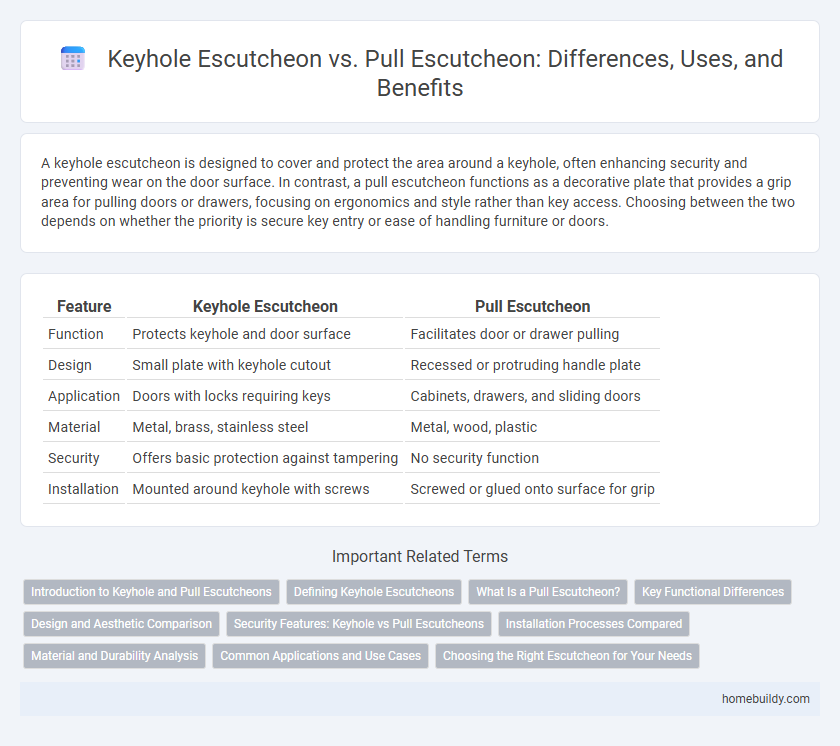A keyhole escutcheon is designed to cover and protect the area around a keyhole, often enhancing security and preventing wear on the door surface. In contrast, a pull escutcheon functions as a decorative plate that provides a grip area for pulling doors or drawers, focusing on ergonomics and style rather than key access. Choosing between the two depends on whether the priority is secure key entry or ease of handling furniture or doors.
Table of Comparison
| Feature | Keyhole Escutcheon | Pull Escutcheon |
|---|---|---|
| Function | Protects keyhole and door surface | Facilitates door or drawer pulling |
| Design | Small plate with keyhole cutout | Recessed or protruding handle plate |
| Application | Doors with locks requiring keys | Cabinets, drawers, and sliding doors |
| Material | Metal, brass, stainless steel | Metal, wood, plastic |
| Security | Offers basic protection against tampering | No security function |
| Installation | Mounted around keyhole with screws | Screwed or glued onto surface for grip |
Introduction to Keyhole and Pull Escutcheons
Keyhole escutcheons provide a decorative and protective cover specifically designed for keyholes on doors or cabinets, enhancing security and aesthetic appeal while preventing wear around the keyhole area. Pull escutcheons function primarily as handles or grips, allowing easy opening of drawers or doors without covering a lock mechanism. Both escutcheon types serve distinct purposes: keyhole escutcheons focus on lock access and protection, whereas pull escutcheons emphasize usability and design integration.
Defining Keyhole Escutcheons
Keyhole escutcheons are metal or brass plates designed to surround and protect the keyhole on doors, providing both security and aesthetic appeal. Unlike pull escutcheons, which are designed as handles to facilitate door opening, keyhole escutcheons emphasize safeguarding the lock mechanism and preventing wear around the keyhole area. These escutcheons come in various shapes and finishes, tailored to match door hardware and enhance overall design coherence.
What Is a Pull Escutcheon?
A pull escutcheon is a decorative plate designed to cover the area around a door handle or drawer pull, enhancing the aesthetic appeal while protecting the surface from wear. Unlike a keyhole escutcheon, which surrounds and reinforces a keyhole, a pull escutcheon focuses on supporting and complementing the hardware used for pulling or opening. Pull escutcheons often feature various shapes and finishes to match cabinetry or furniture styles, providing both functional and ornamental value.
Key Functional Differences
Keyhole escutcheons primarily serve to protect and decorate the edges of keyholes, providing a precise fit for locking mechanisms while preventing wear and tampering. Pull escutcheons are designed for grip and ease of operation, focusing on facilitating the opening and closing of drawers or cabinet doors rather than securing locks. The key functional difference lies in the keyhole escutcheon's role in security and alignment of keys versus the pull escutcheon's emphasis on ergonomic handling.
Design and Aesthetic Comparison
Keyhole escutcheons feature a discreet design that seamlessly integrates with traditional and vintage furniture, emphasizing subtlety and elegance around keyholes. Pull escutcheons prioritize functionality with a more pronounced grip area, often resulting in a bolder and industrial aesthetic suitable for modern interiors. The choice between keyhole and pull escutcheons depends on the desired balance between ornamental appeal and practical use in furniture design.
Security Features: Keyhole vs Pull Escutcheons
Keyhole escutcheons offer enhanced security features by providing precise alignment and protection around keyholes, minimizing tampering and unauthorized access risks. Pull escutcheons primarily serve as handles with limited security functions, lacking reinforcement or shielding capabilities around locking mechanisms. Keyhole escutcheons often incorporate anti-drill and pick-resistant materials, making them superior for securing doors compared to pull escutcheons.
Installation Processes Compared
Keyhole escutcheons typically require precise alignment with the lock mechanism during installation, involving drilling and careful positioning to ensure a secure fit. In contrast, pull escutcheons generally have a simpler installation process, often attaching with surface screws or adhesive without the need for precise lock alignment. The keyhole escutcheon installation demands more detailed measurements and tools, while pull escutcheons offer quicker and more straightforward mounting options suitable for various door types.
Material and Durability Analysis
Keyhole escutcheons are typically crafted from metals such as brass, stainless steel, or zinc alloy, offering superior durability and corrosion resistance compared to many pull escutcheons that use lighter materials like plastic or aluminum. The robust metallic composition of keyhole escutcheons ensures long-lasting protection for keyholes against wear and environmental damage, making them ideal for high-traffic doors. In contrast, pull escutcheons prioritize aesthetic design and ergonomics but may sacrifice some durability due to thinner or less resilient materials.
Common Applications and Use Cases
Keyhole escutcheons are primarily used for securing doors and furniture with key-operated locks, providing a discreet and protective cover for keyholes in residential and commercial settings. Pull escutcheons serve as reinforced handles or grips on drawers, cabinets, and sliding doors, designed to facilitate easy opening without the need for keys. Keyhole escutcheons are ideal for security-focused applications, while pull escutcheons enhance functionality and ergonomics in furniture and cabinetry.
Choosing the Right Escutcheon for Your Needs
Keyhole escutcheons are designed specifically to protect and enhance the aesthetics around keyholes, offering a precise fit that prevents wear and provides security. Pull escutcheons serve as decorative plates for door handles or pulls but lack the functionality to safeguard keyholes from damage or dirt. Choosing the right escutcheon depends on whether you need protection and reinforcement for a keyhole or a stylish finish for a door handle, ensuring both functionality and design coherence in your space.
Keyhole escutcheon vs Pull escutcheon Infographic

 homebuildy.com
homebuildy.com